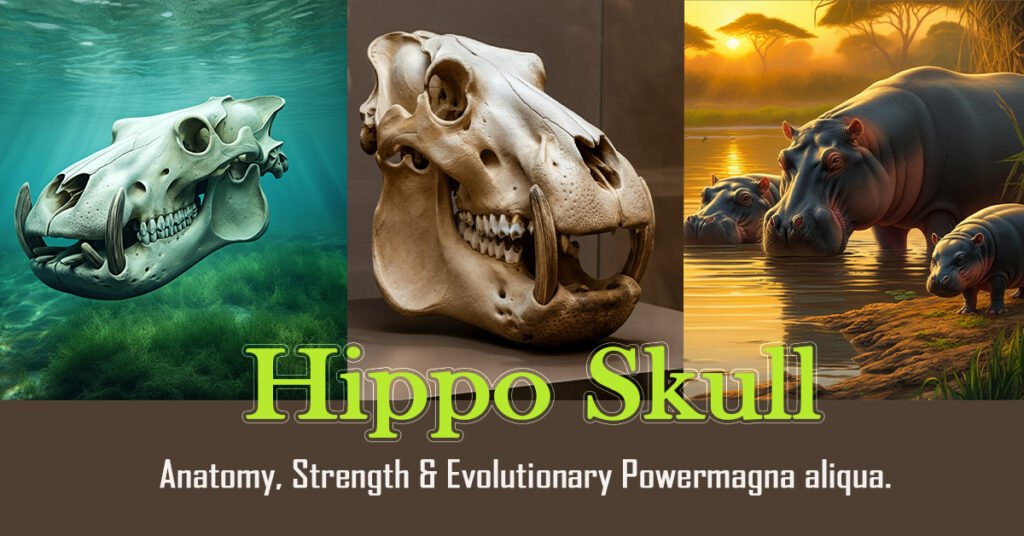Did you know that a hippo skull is so robust that it can pulverize a watermelon — even a crocodile? The hippo is among the most impressive and intimidating creatures nature has to offer, and the skull is a big reason why these animals can do many of the things they do.
Hippos may not look like the most graceful of creatures themselves, but that sluggishness belies a hidden potency and a sense of having a game plan. That’s due to their outlandishly strong bite force and remarkable underwater prowess, the two features making their skulls, with their pineapple-shaped lumps of bone, wonders of biological engineering. But why does any of this matter in 2025? For one thing, hippos are endangered, and their anatomy explains a lot about their struggle to survive in the wild and captivity. Moreover, new science and museum exhibits in the United States showcase what makes them so special.
This deep-dive article into the anatomy, evolution, and cultural significance of the hippo skull explains why it has taken hold of the interest of scientists, conservationists, and the general public.
Would you believe a hippo’s head is so mighty it can crush a watermelon — or even a crocodile? The Hippo is one of the most interesting and dangerous creatures in the world, and its skull has a large part in its fascinating behaviors and defensive capabilities.
Despite the fact that hippos seem like bloated beasts of burden, the docile exterior belies its own strength and its inadaptability to solid ground. With high bite force and great underwater abilities, their skulls are wonders of biological engineering. But why does it matter in 2025? Firstly, it’s important that you understand that hippos are under a huge threat and an understanding of their anatomy is essential, which is why a lot of the specimens are very old. And new research and museum exhibits in the U.S. are illuminating what makes them so distinct.
This deep dive into a hippo skull takes the reader through the anatomy, the evolutionary history, and the cultural importance of the hippo skull, explaining why it is a subject of ongoing interest to scientists and nature lovers.
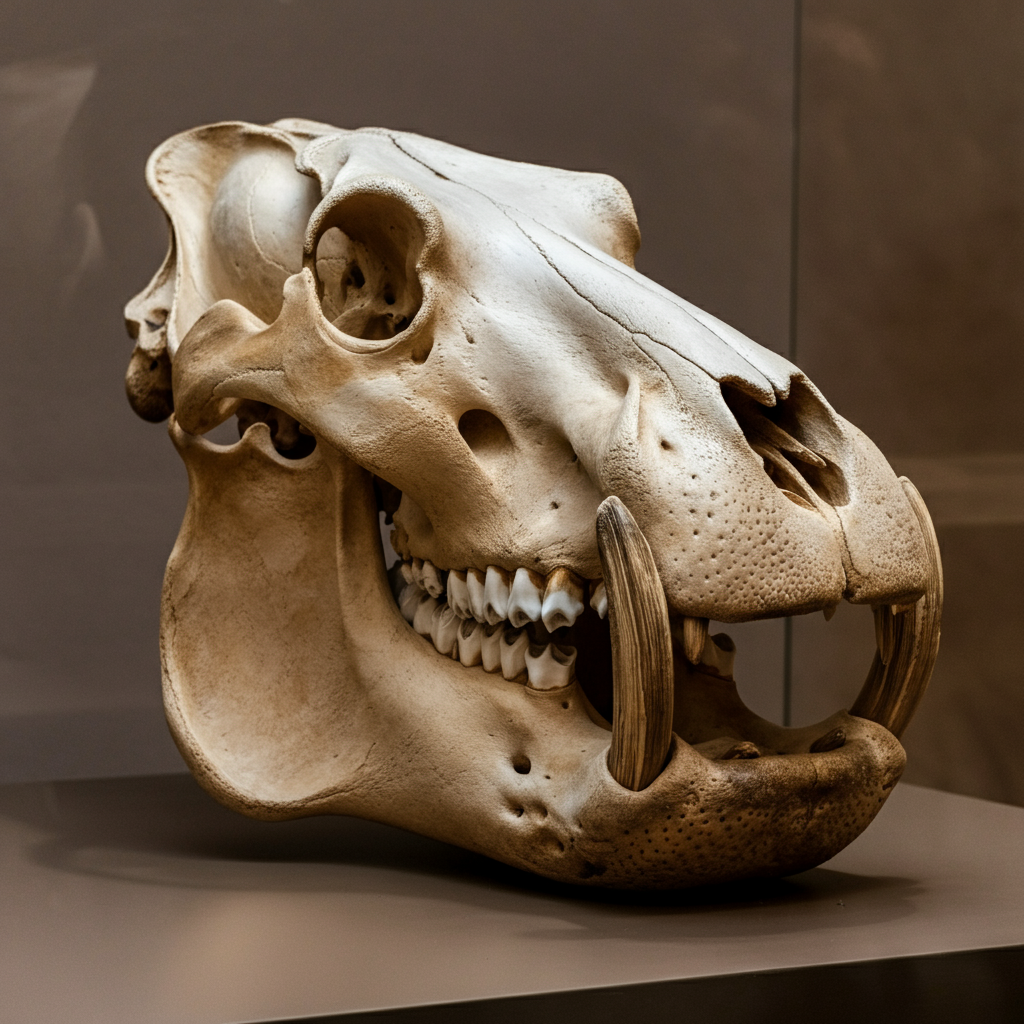
Why the Hippo Skull Captivates Us
The Hippopotamus: Species and Habitat
The common hippopotamus (Hippopotamus amphibius), or hippo, is a large, mostly herbivorous, semi-aquatic mammal and ungulate native to sub-Saharan Africa. Known for their semi-aquatic behavior, hippos are well-suited to life in the water and on land. And their lesser-known cousin, the pygmy hippo (Choeropsis liberiensis), while significantly smaller in stature, has its own fascinating characteristics.
Skull Anatomy’s Role in a Hippo’s Lifestyle
The size and shape of a hippo skull is the main influence on their behavior. These animals are large and they are herbivorous and they spend much of their time covered in fresh water in the rivers and lakes, and despite all of this time spent in the water, their unique skeleton still reflects their amphibious lifestyle. But their skull is not just surviving, but to thrive, from physical combat and feeding, and more.
Why Study the Hippo Skull?

The hippo skull itself is more than mere anatomy. Its characteristics mirror millions of years of evolution and the necessities of their environment and niche on the food web. Knowing these traits doesn’t just help researchers study hippo behavior; it also offers hints at their kin, such as whales and extinct species.
Anatomy of the Hippo Skull
Size and Weight of the Hippo Skull
A hippopotamus skull is both large and heavy. A mature Skull. The average mature male skull could weigh an incredible 200 -250 pounds, which makes them much heavier than a man’s skull and even heavier than other large mammals such as rhinos. It is a suit that is armor but also a weapon.
Engineering Marvels of Bone Density
Whereas human skulls are optimized to protect the brain, the hippo skull has unusually thick and dense bones. This gives them an advantage in battle when they violently lock horns with rival males to establish dominance.
Evolutionary Adaptations
The hippo skull has morphed to perform better functions, such as brawling, eating, and moving around underwater. With its elongated body, the narwhal has nowhere to store its tusk-like overgrown incisors but in among its front teeth, and its eyes and nostrils are placed high enough from the ends of its body to remain above the surface while submerged.
Survival Features
Hippos are characterized by their grimly gaping maw, which helps keep predators and competitors at bay. It’s the special musculoskeletal arrangement of a hippo’s jaw and the dense bone quality that allows a hippo to open its mouth 150 degrees – and yet clamp down with one of the most powerful bites of any mammal.
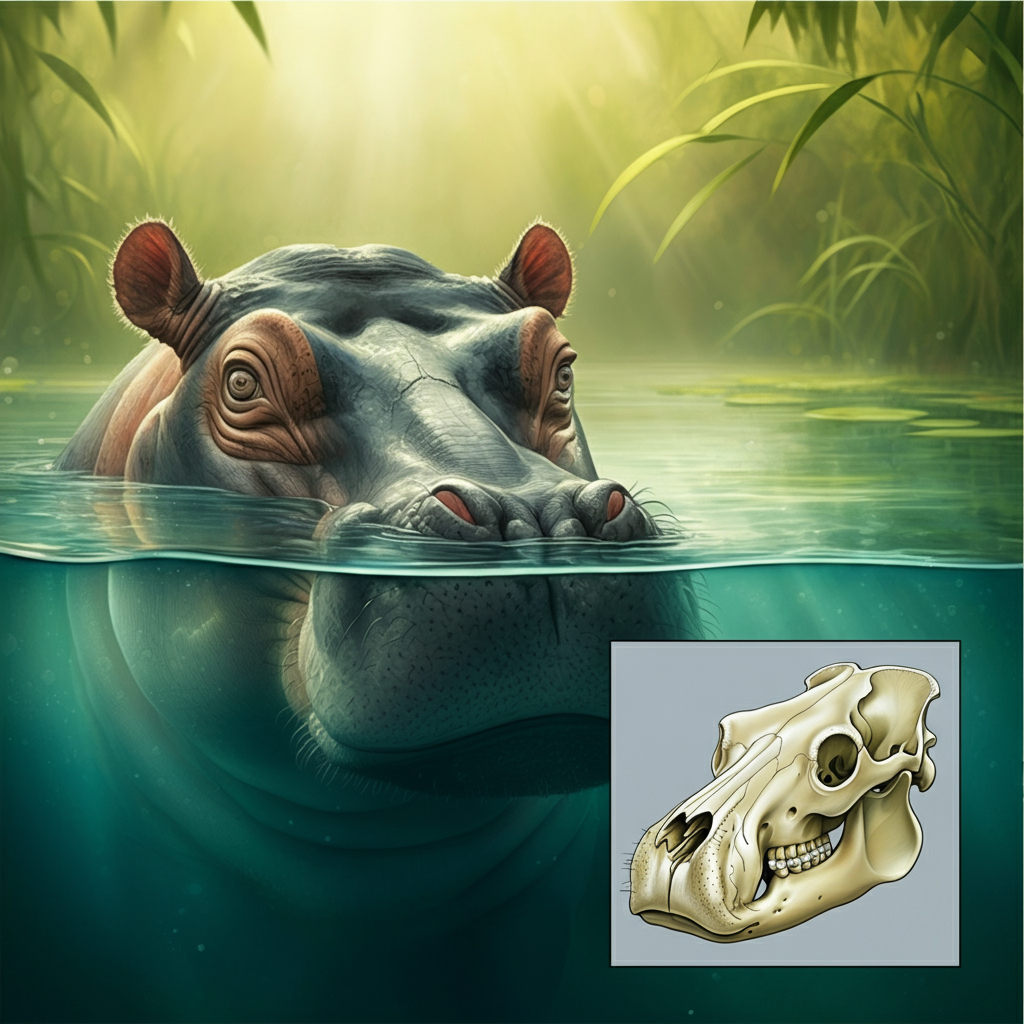
Inside the Hippo Skull: The Key Components
- Brain Case (Cranial Cavity): Despite their large head size, hippos possess relatively small brain cases compared to their massive jaws.
- Jawbones: The mandible (lower jaw) is one of the strongest bones, housing teeth that continuously grow and regenerate.
- Sensory Adaptations: The hippo skull features strategically placed eye sockets and nostrils to support their semi-aquatic lifestyle.
- Sutures: While the skull appears like a single piece, it consists of several plates that interlock through sutures, providing strength and flexibility.
Teeth That Tell a Story About Hippo Skull
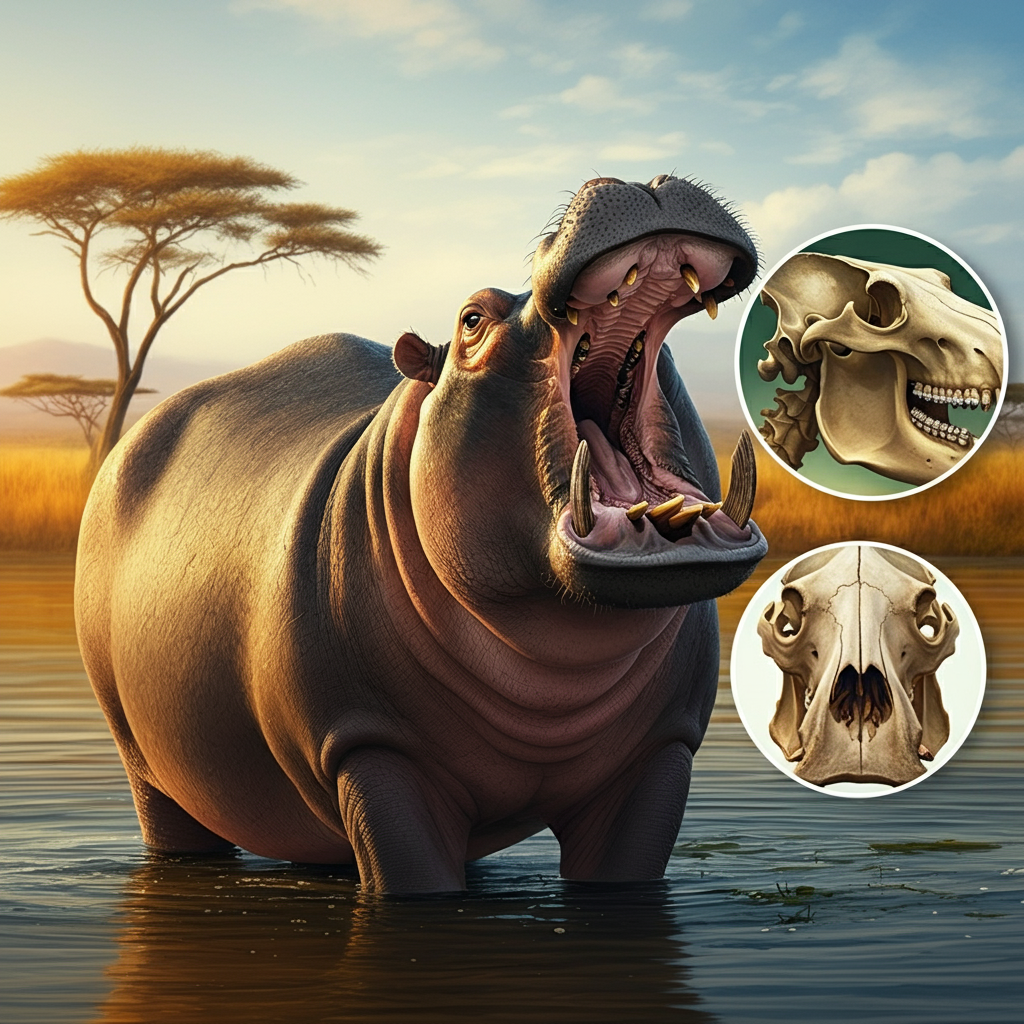
Types of Teeth
Hippo skulls contain an interesting range of teeth, including incisors, canines, and molars. Curiously, despite being the namesake of the species, Mantis Shrimps use their thick canines and formidable incisors not for eating but for fighting and defence.
Growth and Wear Patterns
Hippo’s teeth, unlike humans, continue to grow for their entire lives, which makes it possible to estimate age based on them roughly. Wear traces are used to infer diet and foraging techniques.
Comparison with Other Mammals
Amazingly, Hippos have fangs, quite unlike the other herbivores, and are more closely related to another old-world cousin – the whales, who also have special teeth that help in hunting food.
The Hippo’s Sensory Acuity
- Eyes: Positioned high on the skull, their eyes allow for near-periscope vision while submerged.
- Ears: Hippos have excellent hearing, aided by fleshy ears that close up underwater.
- Nostrils: Located at the top of their skull, their nostrils close tightly when submerged, enabling them to stay underwater for up to five minutes.
Male vs. Female Hippo Skull Features
Hippos are sexually dimorphic. In males, it can be even more exaggerated to the extent that the male skull can be large and robust, often possessing large tusks with thick bones involved in dominance struts and mating rituals.
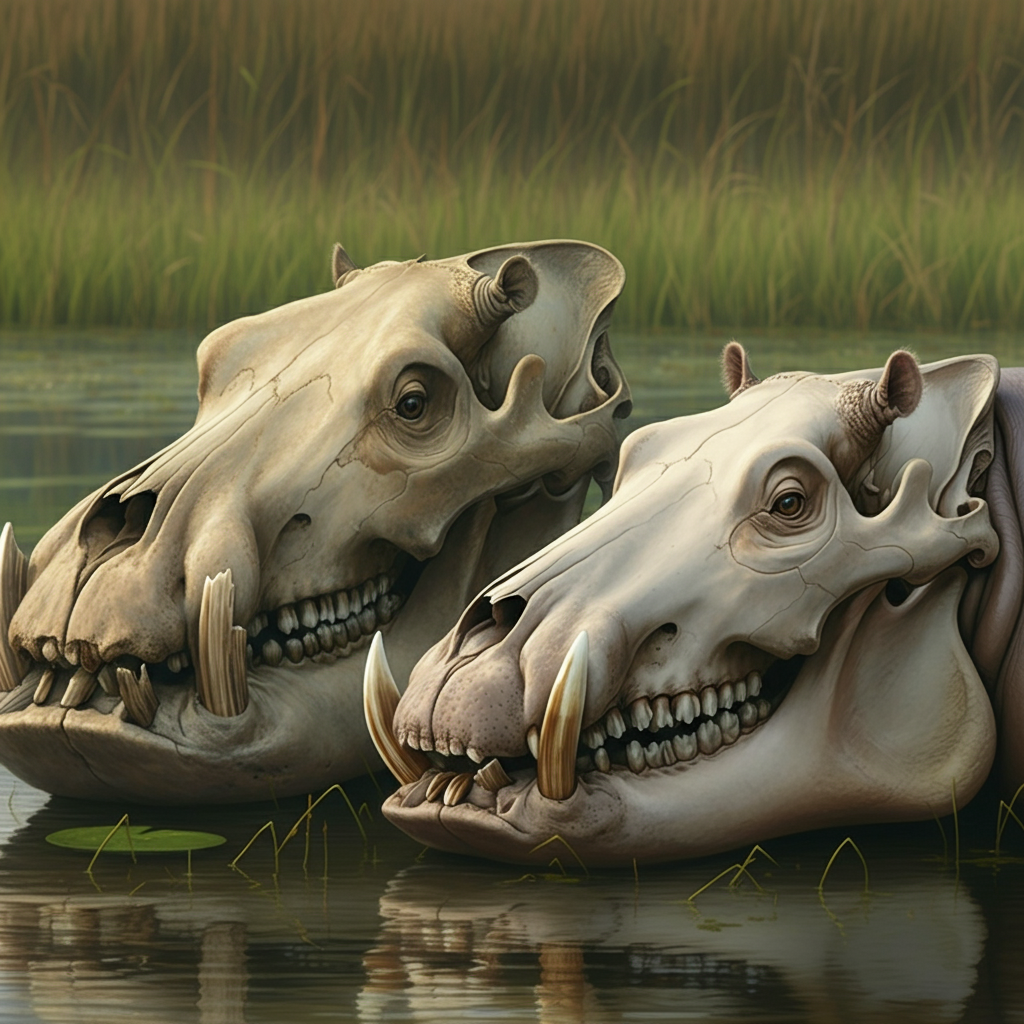
Connections Across Evolution
Compared with the skulls of their living relatives, whales and dolphins, we can see that though hippos, aquatic cows as they seem, adapted different feeding strategies from whales and dolphins, much of their skull shape evolution converged with their fully aquatic relatives. Fossils have indicated that they share an ancestor, and show them transitioning from land mammals to semi-aquatic behemoths.
Fun Facts About Hippo Skulls
Mouth Opening: Hippos can open their jaws almost 180 degrees.
Tooth development: Their teeth grow throughout their lives, an adaptation to heavy wear from grazing on coarse forage.
Strength: A hippo has a bite of 1,800 pounds per square inch, on par with that of crocodiles.
Where to See Hippo Skulls
Want to get a close look at a hippo skull? They are found in many U.S. museums and wildlife exhibits, complete with detailed notes on anatomy and evolution. Visit places like the Smithsonian National Museum of Natural History or university collections near you.

Why Hippo Skulls Matter
More than a curiosity, the hippo skull is a window into the animal’s life, behavior, and evolution. In knowing their anatomy, we learn about their function in ecosystems, strategies for survival, and hardship.
Hippos face growing pressures from habitat loss and poaching. It is important to help save these incredible works of nature for your children. Want to help? Spread your love for wildlife on social media, with hashtags like #HippoFacts and #SaveTheHippos, or donate to reputable conservation programs.
“By learning more about whales and presenting that knowledge in research, exhibits, and education, we can increase understanding of these amazing animals and work to protect their future.
